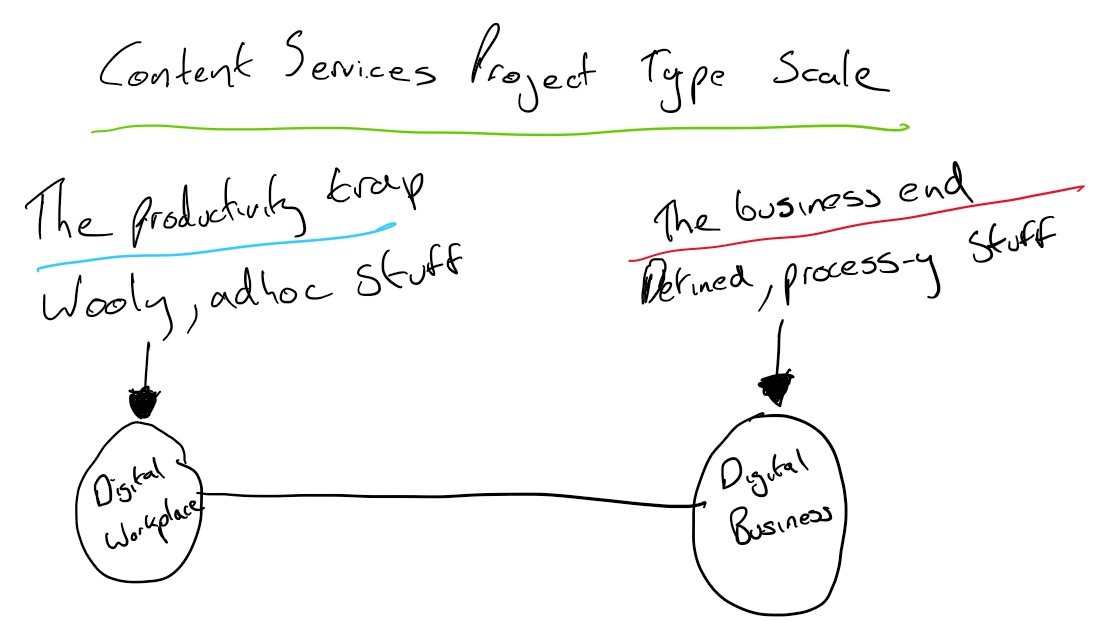
This post is the first in (beyond Hann’s introduction )in our CuSP series. This will include a great bunch of contributors for this with a huge amount of experience in the content services industry (including my new-ish colleagues Marko and Lane – welcome guys!). Check back regularly for other articles.
So, you are about to embark on a content services project (note, not ECM, we STILL believe that is dead). I would hazard a guess that the outcome of the project is somewhat aligned with either digital workplace or digital business objectives. i.e. it lies at either end of the elaborate project type model I have drawn below (drawing is not my forte as I am sure you have guessed).
At some point in the project planning someone (I’m guessing you as your reading this article) is going to be asked to justify the value of this project. What are we actually going to achieve by doing this? CSP projects are not cheap and can be risky so it’s not surprising that the holder of the purse strings wants some idea of what they are getting for their money. Projects that are on the right hand of model above, “the business end” if you like, are usually quite easy to define in terms of expected benefits. They have very tangible outputs, e.g. increased profits, reduced cycles times, greater levels of customer satisfaction and so on. Projects on the left hand side are where we have a challenge, they are usually aimed at a productivity drive across departments or even the entire organization and as such the actual outputs are considerably more vague and difficult to get a handle on. You know, the wooly, adhoc stuff. This is the “productivity trap”
For those with experience in the productivity trap, raise your hand if you have ever put together a business case based on shaving off small amounts of time from an action (“10 seconds off every search!”) and then extrapolated that out to calculate ROI (“Saving 20 FTEs per year – ROI in 5 years!”). I know I have. Now keep your hands raised if that ever worked. I’m hoping most hands went down at that point (If your hand is still raised. Maybe switch and raise your other hand so people will think you are stretching.). It’s impossible to define value in this way
Digital Dexterity
There is a better way of doing this. At Gartner we talk about the concept of digital dexterity. and there is considerable depth to this that I’m not going to go into here. At the simplest level however, it’s about empowering ALL users, not just the technically savvy, to make the best use of the new forms of technology that are continually invading our work place. Content plays a huge part in this. If we look at some of the key attributes of digital dexterity we can see why:
- Agile: The ability to consume and interact with content wherever we are and using whichever medium we have access to. Seamless mobile connectivity is a critical element of this.
- Analytical: Content can simplify the way we can to analyse and derive insights from data. Content is a familiar end user format and as such we can use it for many activities. We can gather intelligence in interactive dashboard material or exploit its familiarity to ease the way we work with complex structure data sources (think of tools like Quip or Smartsheet).
- Collaborative: The explosion of content collaboration platforms like Box, Dropbox and Google Drive has highlighted the importance of enabling collaboration both inside and outside the organization, whilst adhering to organizational privacy and security controls.
- Innovative and Creative: The traditional office format is not appropriate for all work styles and can be restrictive. Digital dexterity of the entire workforce means providing users with tools that encourages rather than limits innovation and creativity. Examples include generating interactive content using Microsoft tools like Power Apps and Flow or creating visually rich outputs using tools like Dropbox Showcase, Presi or Adobe Creative Suite.
Focusing on these digital dexterity related attributes is a great way to provide a foundational component to any digital workplace related content program. There are also ways to track and measure. For example;
- Are users actually utilizing the mobile applications – what apps are they consuming?
- Who are files being shared with? are there patterns to the collaboration you can use to identify clusters of activity?
- What data sources are being consumed in content enabled applications?
Combining these system measurements and more, which are available in most modern content services platforms, with the measurement of HR and business metrics is the grounding of measuring digital dexterity and the impact your content services implementation has upon it. For those interested in taking this further (and you’ve got this far so that seems likely), I fully recommend taking a look at Gartner’s digital dexterity index research which includes toolkits for benchmarking and tracking progress amongst your target user community.
The Pay Off
And then what about the pay off? What is it the point in digital dexterity? Well, our studies have shown that where levels of digital dexterity in an organization are high, those organizations are three times quicker to launch, complete and gain value from digital business initiatives than other organizations. If you’re an organization undergoing digital transformation (as we all are) that’s hard to ignore. Coming back to my elaborate diagram above, from a content services perspective that makes the adhoc wooly stuff as important to get right as the well defined process-type stuff as one amplifies the likelihood of success of the other. This is important as although the benefits of the right hand side digital business programs are easy to define, the projects themselves are typically complex and fraught with risk. A more digitally dexterous workforce massively increases the chances of their success.
Shameless Plug
This is obviously only a short introduction to the concept of digital dexterity. One way to get more insight into this (shameless plug approaching – I am the chair for it so think that is allowed) is to get yourself to the Gartner Digital Workplace Summit in London on the 12-13th September (as I write, next week!). If that floats your boat I look forward to seeing you there.
Category: content-services content-services-platforms digital-workplace-applications digital-workplace-program ecm enterprise-content-management the-cusp
Tags: content-services content-services-platforms digital-workplace document-management ecm the-cusp
read more at https://blogs.gartner.com/digital-marketing by Michael Woodbridge
Cio







